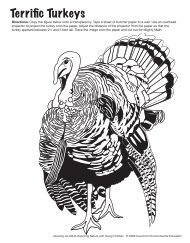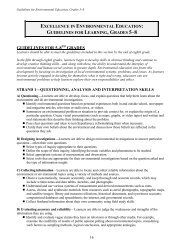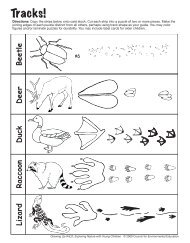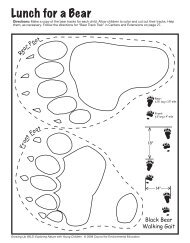Science correlations, grades 9-12 - Project Wild
Science correlations, grades 9-12 - Project Wild
Science correlations, grades 9-12 - Project Wild
You also want an ePaper? Increase the reach of your titles
YUMPU automatically turns print PDFs into web optimized ePapers that Google loves.
<strong>Project</strong> WILD and Aquatic WILD<br />
Correlations to Indiana <strong>Science</strong><br />
Standards, <strong>grades</strong> 9-<strong>12</strong><br />
Correlated by Ms. Nancy Leininger<br />
Curriculum Coordinator, Northwest Allen County Schools<br />
Facilitator for <strong>Project</strong>s Learning Tree, WET, and WILD<br />
July 2009<br />
Indiana <strong>Project</strong> WILD<br />
Mary Hayes, Coordinator<br />
Natural Resources Education Center, Fort Harrison State Park<br />
5785 Glenn Road<br />
Indianapolis, IN 46216<br />
(317) 549-0348<br />
FAX (317) 562-0790<br />
projectwild@dnr.in.gov<br />
www.in.gov/dnr/nrec
Biology<br />
Principles of Biology<br />
Students work with the concepts, principles, and theories that enable them to understand the<br />
livingenvironment. They recognize that living organisms are made of cells or cell products that<br />
consist of the same components as all other matter, involve the same kinds of transformation of<br />
energy, and move using the same kinds of basic forces. Students investigate, through<br />
laboratories and fieldwork, how living things function and how they interact with one another and<br />
their environment.<br />
B.1.7 Explain that complex interactions among the different kinds of molecules in the cell cause<br />
distinct cycles of activities, such as growth and division. Note that cell behavior can also be<br />
affected by molecules from other parts of the organism, such as hormones. (Core Standard)<br />
PWA: Hooks and Ladders p. 43<br />
B.1.17 Understand that and describe how the maintenance of a relatively stable internal<br />
environment is required for the continuation of life and explain how stability is challenged by<br />
changing physical, chemical, and environmental conditions, as well as the presence of disease<br />
agents.<br />
PW: How Many Bears Can Live in This Forest? p. 23<br />
Microtrek Treasure Hunt p. 82<br />
Birds of Prey p. 111<br />
Quick Frozen Critter p. <strong>12</strong>2<br />
Polar Bears in Phoenix? p. <strong>12</strong>5<br />
I'm Thirsty p. 134<br />
Move Over Rover p. 144<br />
Planting Animals p. 152<br />
Here Today, Gone Tomorrow p. 154<br />
Time Lapse p. 158<br />
Bottleneck Genes p. 172<br />
Ethi-Reasoning p. 203<br />
Arctic Survival p. 234<br />
Changing Societies p. 258<br />
Hazardous Links, Possible Solutions p. 326<br />
Rare Bird Eggs for Sale p. 335<br />
Changing the Land p. 345<br />
Back from the Brink p. 355<br />
Career Critters p. 371<br />
Checks and Balances p. 387<br />
Deer Crossing p. 392<br />
From Bison to Bread: The American Prairie pg. 395<br />
A Picture is Worth a Thousand Words p. 409<br />
Deer Dilemma p. 426<br />
Improving <strong>Wild</strong>life Habitat in the Community p. 440<br />
Can Do! p. 446<br />
PWA: Fishy Who's Who p. 8<br />
Migration Headache p. 15<br />
Designing a Habitat p. 19<br />
Water Canaries p. 24<br />
Blue-Ribbon Niche p. 52<br />
Eat and Glow p. 69
Net Gain, Net Effect p. 85<br />
When a Whale is Right p. 94<br />
Sea Turtles International p. 98<br />
What's in the Air? p. 136<br />
What’s in the Water p. 140<br />
Something's Fishy Here! p. 145<br />
Alice in Waterland p. 154<br />
The Glass Menagerie p. 155<br />
Fishable Waters p. 158<br />
Turtle Hurdles p. 172<br />
Aquatic Roots p. 163<br />
Where Have All the Salmon Gone? p. 180<br />
To Dam or Not to Dam p. 170<br />
Dam Design p. 193<br />
Dragonfly Pond p. 184<br />
B.1.18 Explain that the regulatory and behavioral responses of an organism to external stimuli<br />
occur in order to maintain both short-and long-term equilibrium.<br />
PW: Microtrek Treasure Hunt p. 82<br />
B.1.21 Understand and explain that the information passed from parents to offspring is<br />
transmitted by means of genes which are coded in DNA molecules. (Core Standard)<br />
PW: Bottleneck Genes p. 172<br />
B.1.27 Explain that the similarity of human DNA sequences and the resulting similarity in cell<br />
chemistry and anatomy identify human beings as a unique species, different from all others.<br />
Likewise, understand that every other species has its own characteristic DNA sequence. (Core<br />
Standard)<br />
PW: Urban Nature Search p. 70<br />
B.1.28 Illustrate that the sorting and recombination of genes in sexual reproduction results in a<br />
great variety of possible gene combinations from the offspring of any two parents. Recognize that<br />
genetic variation can occur from such processes as crossing over, jumping genes, and deletion<br />
and duplication of genes. (Core Standard)<br />
PW: Bottleneck Genes p. 172<br />
B.1.29 Understand that and explain how the actions of genes, patterns of inheritance, and the<br />
reproduction of cells and organisms account for the continuity of life, and give examples of how<br />
inherited characteristics can be observed at molecular and whole-organism levels - in structure,<br />
chemistry, or behavior. (Core Standard)<br />
PW: Bottleneck Genes p. 172<br />
B.1.31 Describe how natural selection provides the following mechanism for evolution: Some<br />
variation in heritable characteristics exists within every species, and some of these characteristics<br />
give individuals an advantage over others in surviving and reproducing. Understand that the<br />
advantaged offspring, in turn, are more likely than others to survive and reproduce. Also<br />
understand that the proportion of individuals in the population that have advantageous<br />
characteristics will increase. (Core Standard)<br />
PW: Bottleneck Genes p. 172
Dropping In On Deer p. 421<br />
B.1.32 Explain how natural selection leads to organisms that are well suited for survival in<br />
particular environments, and discuss how natural selection provides scientific explanation for the<br />
history of life on Earth as depicted in the fossil record and in the similarities evident within the<br />
diversity of existing organisms. (Core Standard)<br />
PW: Bottleneck Genes p. 172<br />
B.1.36 Trace the relationship between environmental changes and changes in the gene pool,<br />
such as genetic drift and isolation of sub-populations. (Core Standard)<br />
PW: Bottleneck Genes p. 172<br />
B.1.37 Explain that the amount of life any environment can support is limited by the available<br />
energy, water, oxygen, and minerals, and by the ability of ecosystems to recycle the residue of<br />
dead organic materials. Recognize, therefore, that human activities and technology can change<br />
the flow and reduce the fertility of the land. (Core Standard)<br />
PW: How Many Bears Can Live in This Forest? p. 23<br />
Oh Deer! p. 36<br />
We're In This Together p. 44<br />
Carrying Capacity p. 46<br />
Habitat Lap Sit p. 61<br />
Which Niche? p. 66<br />
What Did Your Lunch Cost <strong>Wild</strong>life? p. 68<br />
Rainfall and the Forest p. 73<br />
Microtrek Treasure Hunt p. 82<br />
Ants on a Twig p. 88<br />
Birds of Prey p. 111<br />
Quick Frozen Critter p. <strong>12</strong>2<br />
Muskox Maneuvers p. 130<br />
I'm Thirsty p. 134<br />
Fire Ecologies p. 140<br />
Planting Animals p. 152<br />
Here Today, Gone Tomorrow p. 154<br />
Time Lapse p. 158<br />
Ecosystem Facelift p. 166<br />
Bottleneck Genes p. 172<br />
Prairie Memoirs p. 188<br />
Ethi-Reasoning p. 203<br />
Arctic Survival p. 234<br />
Let's Talk Turkey p. 248<br />
Shrinking Habitat p. 310<br />
Hazardous Links, Possible Solutions p. 326<br />
World Travelers p. 330<br />
Riparian Zone p. 341<br />
Changing the Land p. 345<br />
Back from the Brink p. 355<br />
Career Critters p. 371<br />
Checks and Balances p. 387<br />
Deer Crossing p. 393<br />
From Bison to Bread: The American Prairie pg. 395<br />
Bird Song Survey p. 406<br />
A Picture is Worth a Thousand Words p. 409<br />
Dropping In On Deer p. 421
Deer Dilemma p. 426<br />
Planning for People and <strong>Wild</strong>life p. 436<br />
Improving <strong>Wild</strong>life Habitat in the Community p. 440<br />
Can Do! p. 446<br />
Sustainability: Then, Now, Later p. 449<br />
PWA: Migration Headache p. 15<br />
Designing a Habitat p. 19<br />
Water Canaries p. 24<br />
Wetland Metaphors p. 39<br />
Hooks and Ladders p. 43<br />
Blue-Ribbon Niche p. 52<br />
When a Whale is Right p. 94<br />
Puddle Wonders! p. 114<br />
Riparian Retreat p. 118<br />
What's in the Air? p. 136<br />
What’s in the Water p. 140<br />
Something's Fishy Here! p. 145<br />
Alice in Waterland p. 154<br />
The Glass Menagerie p. 155<br />
Fishable Waters p. 158<br />
Turtle Hurdles p. 172<br />
Aquatic Roots p. 163<br />
Where Have All the Salmon Gone? p. 180<br />
To Dam or Not to Dam p. 170<br />
Dragonfly Pond p. 184<br />
B.1.38 Understand and explain the significance of the introduction of species, such as zebra<br />
mussels, into American waterways, and describe the consequent harm to native species and the<br />
environment in general. (Core Standard)<br />
PW: Move Over Rover p. 144<br />
Planting Animals p. 152<br />
Time Lapse p. 158<br />
World Travelers p. 330<br />
Career Critters p. 371<br />
PWA: Blue-Ribbon Niche p. 52<br />
What’s in the Water p. 140<br />
Aquatic Roots p. 163<br />
B.1.39 Describe how ecosystems can be reasonably stable over hundreds or thousands of<br />
years. Understand that if a disaster such as flood or fire occurs, the damaged ecosystem is likely<br />
to recover in stages that eventually result in a system similar to the original one. (Core Standard)<br />
PW: Carrying Capacity p. 46<br />
Habitat Lap Sit p. 61<br />
Birds of Prey p. 111<br />
Quick Frozen Critter p. <strong>12</strong>2<br />
Forest in a Jar p. 137<br />
Fire Ecologies p. 140<br />
Time Lapse p. 158<br />
Ecosystem Facelift p. 166<br />
Prairie Memoirs p. 188<br />
Smokey Bear Said What? p. 314
Back from the Brink p. 355<br />
From Bison to Bread: The American Prairie pg. 395<br />
PWA: Pond Succession p. 66<br />
Watered-Down History p. 91<br />
When a Whale is Right p. 94<br />
B.1.40 Understand and explain that like many complex systems, ecosystems tend to have cyclic<br />
fluctuations around a state of rough equilibrium. However, also understand that ecosystems can<br />
always change with climate changes or when one or more new species appear as a result of<br />
migration or local evolution. (Core Standard)<br />
PW: How Many Bears Can Live in This Forest? p. 23<br />
Oh Deer! p. 36<br />
Carrying Capacity p. 46<br />
Birds of Prey p. 111<br />
Quick Frozen Critter p. <strong>12</strong>2<br />
Time Lapse p. 158<br />
Bottleneck Genes p. 172<br />
Back from the Brink p. 355<br />
From Bison to Bread: The American Prairie pg. 395<br />
PWA: Migration Headache p. 15<br />
When a Whale is Right p. 94<br />
Puddle Wonders! p. 114<br />
B.1.41 Recognize that and describe how human beings are part of the Earth's ecosystems. Note<br />
that human activities can, deliberately or inadvertently, alter the equilibrium in ecosystems. (Core<br />
Standard)<br />
PW: How Many Bears Can Live in This Forest? p. 23<br />
Oh Deer! p. 36<br />
We're In This Together p. 44<br />
Carrying Capacity p. 46<br />
Habitat Lap Sit p. 61<br />
What Did Your Lunch Cost <strong>Wild</strong>life? p. 68<br />
Urban Nature Search p. 70<br />
Microtrek Treasure Hunt p. 82<br />
Stormy Weather p. 85<br />
Ants on a Twig p. 88<br />
Energy Pipeline p. 105<br />
Birds of Prey p. 111<br />
Muskox Maneuvers p. 130<br />
Forest in a Jar p. 137<br />
Fire Ecologies p. 140<br />
Move Over Rover p. 144<br />
Planting Animals p. 152<br />
Here Today, Gone Tomorrow p. 154<br />
Time Lapse p. 158<br />
Ecosystem Facelift p. 166<br />
Bottleneck Genes p. 172<br />
Museum Search for <strong>Wild</strong>life p. 182<br />
Saturday Morning <strong>Wild</strong>life Watching p. 184<br />
Prairie Memoirs p. 188<br />
Cartoons and Bumper Stickers p. 192<br />
Power of a Song p. 194
For Your Eyes Only p. 197<br />
Ethi-Reasoning p. 203<br />
<strong>Wild</strong>life on Coins and Stamps p. 208<br />
What You Wear is What They Were p. 210<br />
Does <strong>Wild</strong>life Sell? p. 213<br />
Pay to Play p. 216<br />
Arctic Survival p. 234<br />
Lobster in Your Lunch Box p. 245<br />
Let's Talk Turkey p. 248<br />
<strong>Wild</strong>life Bibliography p. 253<br />
Changing Attitudes p. 255<br />
Changing Societies p. 258<br />
History of <strong>Wild</strong>life Management p. 267<br />
<strong>Wild</strong> Bill's Fate p. 270<br />
Know Your Legislation: What's in it for <strong>Wild</strong>life? p. 272<br />
Drawing on Nature p. 285<br />
The Hunter p. 287<br />
<strong>Wild</strong>life Issues: Community Attitude Survey p.297<br />
No Water Off a Duck's Back p. 305<br />
Migration Barriers p. 308<br />
Shrinking Habitat p. 310<br />
Smokey Bear Said What? p. 314<br />
Noisy Neighbors p. 317<br />
Flip the Switch for <strong>Wild</strong>life p. 319<br />
To Zone or Not to Zone p. 321<br />
Hazardous Links, Possible Solutions p. 326<br />
Rare Bird Eggs for Sale p. 335<br />
Pro and Con: Consumptive and Nonconsumptive Uses of <strong>Wild</strong>life p. 338<br />
Riparian Zone p. 341<br />
Changing the Land p. 345<br />
Cabin Conflict p. 353<br />
Back from the Brink p. 355<br />
Philisophical Differences p. 364<br />
Career Critters p. 371<br />
<strong>Wild</strong>work p. 385<br />
Checks and Balances p. 387<br />
Deer Crossing p. 394<br />
From Bison to Bread: The American Prairie pg. 395<br />
Bird Song Survey p. 406<br />
A Picture is Worth a Thousand Words p. 409<br />
<strong>Wild</strong>life Research p. 418<br />
Deer Dilemma p. 426<br />
Litter We Know p. 434<br />
Planning for People and <strong>Wild</strong>life p. 436<br />
Improving <strong>Wild</strong>life Habitat in the Community p. 440<br />
Enviro-Ethics p. 443<br />
Can Do! p. 446<br />
Sustainability: Then, Now, Later p. 449<br />
PWA: Fishy Who's Who p. 8<br />
Migration Headache p. 15<br />
Designing a Habitat p. 19<br />
Where Does Water Run? p. 21<br />
Water Canaries p. 24<br />
Wetland Metaphors p. 39<br />
Hooks and Ladders p. 43
Blue-Ribbon Niche p. 52<br />
Net Gain, Net Effect p. 85<br />
Watered-Down History p. 91<br />
When a Whale is Right p. 94<br />
Sea Turtles International p. 98<br />
Riparian Retreat p. 118<br />
Watershed p. 132<br />
What's in the Air? p. 136<br />
What’s in the Water p. 140<br />
Something's Fishy Here! p. 145<br />
Water's Going On? p. 149<br />
Alice in Waterland p. 154<br />
The Glass Menagerie p. 155<br />
Fishable Waters p. 158<br />
Turtle Hurdles p. 172<br />
Aquatic Roots p. 163<br />
Where Have All the Salmon Gone? p. 180<br />
To Dam or Not to Dam p. 170<br />
Aquatic Times p. 174<br />
Dam Design p. 193<br />
Kelp Help p. 181<br />
Dragonfly Pond p. 184<br />
Living Research: Aquatic Heroes and Heroines p. 204<br />
B.1.43 Understand that and describe how organisms are influenced by a particular combination<br />
of living and non-living components of the environment. (Core Standard)<br />
PW: Habitat Rummy p. 14<br />
Bearly Growing p. 19<br />
How Many Bears Can Live in This Forest? p. 23<br />
Spider Web Geometry p. 34<br />
Oh Deer! p. 36<br />
We're In This Together p. 44<br />
Carrying Capacity p. 46<br />
Habitat Lap Sit p. 61<br />
Who Fits Here? p. 64<br />
Which Niche? p. 66<br />
What Did Your Lunch Cost <strong>Wild</strong>life? p. 68<br />
Urban Nature Search p. 70<br />
Rainfall and the Forest p. 73<br />
Eco-Enrichers p. 102<br />
Polar Bears in Phoenix? p. <strong>12</strong>5<br />
Adaptation Artistry p. <strong>12</strong>8<br />
I'm Thirsty p. 134<br />
Forest in a Jar p. 137<br />
Fire Ecologies p. 140<br />
Move Over Rover p. 144<br />
Planting Animals p. 152<br />
Here Today, Gone Tomorrow p. 154<br />
Time Lapse p. 158<br />
Ecosystem Facelift p. 166<br />
Bottleneck Genes p. 172<br />
Ethi-Reasoning p. 203<br />
Pay to Play p. 216<br />
Arctic Survival p. 234<br />
Let's Talk Turkey p. 248
Smokey Bear Said What? p. 314<br />
Flip the Switch for <strong>Wild</strong>life p. 319<br />
Hazardous Links, Possible Solutions p. 326<br />
Changing the Land p. 345<br />
Back from the Brink p. 355<br />
Career Critters p. 371<br />
Checks and Balances p. 387<br />
Deer Crossing p. 395<br />
From Bison to Bread: The American Prairie pg. 395<br />
A Picture is Worth a Thousand Words p. 409<br />
Deer Dilemma p. 426<br />
Improving <strong>Wild</strong>life Habitat in the Community p. 440<br />
Can Do! p. 446<br />
PWA: Migration Headache p. 15<br />
Designing a Habitat p. 19<br />
Where Does Water Run? p. 21<br />
Water Canaries p. 24<br />
Hooks and Ladders p. 43<br />
Blue-Ribbon Niche p. 52<br />
Eat and Glow p. 69<br />
Edge of Home p. 75<br />
Net Gain, Net Effect p. 85<br />
Watered-Down History p. 91<br />
When a Whale is Right p. 94<br />
Sea Turtles International p. 98<br />
Puddle Wonders! p. 114<br />
Riparian Retreat p. 118<br />
What's in the Air? p. 136<br />
What’s in the Water p. 140<br />
Something's Fishy Here! p. 145<br />
Alice in Waterland p. 154<br />
The Glass Menagerie p. 155<br />
Fishable Waters p. 158<br />
Turtle Hurdles p. 172<br />
Where Have All the Salmon Gone? p. 180<br />
To Dam or Not to Dam p. 170<br />
Dam Design p. 193<br />
Dragonfly Pond p. 184<br />
B.1.44 Describe the flow of matter, nutrients, and energy within ecosystems. (Core Standard)<br />
PW: Oh Deer! p. 36<br />
Carrying Capacity p. 46<br />
Ants on a Twig p. 88<br />
Good Buddies p. 91<br />
Eco-Enrichers p. 102<br />
Energy Pipeline p. 105<br />
Hazardous Links, Possible Solutions p. 326<br />
PWA: Where Does Water Run? p. 21<br />
B.1.45 Recognize that and describe how the physical or chemical environment may influence<br />
the rate, extent, and nature of the way organisms develop within ecosystems. (Core Standard)
PW: How Many Bears Can Live in This Forest? p. 23<br />
Oh Deer! p. 36<br />
Carrying Capacity p. 46<br />
Habitat Lap Sit p. 61<br />
What Did Your Lunch Cost <strong>Wild</strong>life? p. 68<br />
Urban Nature Search p. 70<br />
Seed Need p. 98<br />
Eco-Enrichers p. 102<br />
Energy Pipeline p. 105<br />
Birds of Prey p. 111<br />
Quick Frozen Critter p. <strong>12</strong>2<br />
Polar Bears in Phoenix? p. <strong>12</strong>5<br />
Muskox Maneuvers p. 130<br />
I'm Thirsty p. 134<br />
Forest in a Jar p. 137<br />
Fire Ecologies p. 140<br />
Move Over Rover p. 144<br />
Planting Animals p. 152<br />
Here Today, Gone Tomorrow p. 154<br />
Time Lapse p. 158<br />
Ecosystem Facelift p. 166<br />
Bottleneck Genes p. 172<br />
Prairie Memoirs p. 188<br />
Ethi-Reasoning p. 203<br />
Pay to Play p. 216<br />
Arctic Survival p. 234<br />
Let's Talk Turkey p. 248<br />
No Water Off a Duck's Back p. 305<br />
Migration Barriers p. 308<br />
Smokey Bear Said What? p. 314<br />
Flip the Switch for <strong>Wild</strong>life p. 319<br />
Hazardous Links, Possible Solutions p. 326<br />
Rare Bird Eggs for Sale p. 335<br />
Riparian Zone p. 341<br />
Changing the Land p. 345<br />
Back from the Brink p. 355<br />
Career Critters p. 371<br />
Checks and Balances p. 387<br />
Deer Crossing p. 396<br />
From Bison to Bread: The American Prairie pg. 395<br />
A Picture is Worth a Thousand Words p. 409<br />
Deer Dilemma p. 426<br />
Improving <strong>Wild</strong>life Habitat in the Community p. 440<br />
Can Do! p. 446<br />
PWA: Migration Headache p. 15<br />
Designing a Habitat p. 19<br />
Where Does Water Run? p. 21<br />
Water Canaries p. 24<br />
Hooks and Ladders p. 43<br />
Blue-Ribbon Niche p. 52<br />
Eat and Glow p. 69<br />
Edge of Home p. 75<br />
Net Gain, Net Effect p. 85<br />
Watered-Down History p. 91<br />
When a Whale is Right p. 94
Sea Turtles International p. 98<br />
Puddle Wonders! p. 114<br />
Riparian Retreat p. 118<br />
What's in the Air? p. 136<br />
What’s in the Water p. 140<br />
Something's Fishy Here! p. 145<br />
Alice in Waterland p. 154<br />
The Glass Menagerie p. 155<br />
Fishable Waters p. 158<br />
Turtle Hurdles p. 172<br />
Aquatic Roots p. 163<br />
Where Have All the Salmon Gone? p. 180<br />
To Dam or Not to Dam p. 170<br />
Dam Design p. 193<br />
Dragonfly Pond p. 184<br />
B.1.46 Recognize and describe that a great diversity of species increases the chance that at<br />
least some living things will survive in the face of large changes in the environment. (Core<br />
Standard)<br />
PW: Ecosystem Facelift p. 166<br />
Bottleneck Genes p. 172<br />
Back from the Brink p. 355<br />
From Bison to Bread: The American Prairie pg. 395<br />
PWA: Edge of Home p. 75<br />
Fishable Waters p. 158<br />
Environment<br />
Principles of Environmental <strong>Science</strong><br />
Students investigate, through laboratory and fieldwork, the concepts of environmental systems,<br />
populations, natural resources, and environmental hazards.<br />
ENV.1.1 Know and describe how ecosystems can be reasonably stable over hundreds or<br />
thousands of years. Consider as an example the ecosystem of the Great Plains prior to the<br />
advent of the horse in Native American Plains societies, from then until the advent of agriculture,<br />
and well into the present.<br />
PW Birds of Prey p. 111<br />
Quick Frozen Critter p. <strong>12</strong>2<br />
Forest in a Jar p. 137<br />
Fire Ecologies p. 140<br />
Time Lapse p. 158<br />
Ecosystem Facelift p. 166<br />
Prairie Memoirs p. 188<br />
Back from the Brink p. 355<br />
From Bison to Bread: The American Prairie pg. 395<br />
PWA Pond Succession p. 66<br />
Watered-Down History p. 91<br />
When a Whale is Right p. 94
ENV.1.2 Understand and describe that if a disaster, such as flood or fire occurs, the damaged<br />
ecosystem is likely to recover in stages that eventually result in a system similar to the original<br />
one.<br />
PW Carrying Capacity p. 46<br />
Habitat Lap Sit p. 61<br />
Fire Ecologies p. 140<br />
Time Lapse p. 158<br />
Ecosystem Facelift p. 166<br />
Smokey Bear Said What? p. 314<br />
From Bison to Bread: The American Prairie pg. 395<br />
ENV.1.3 Understand and explain that ecosystems have cyclic fluctuations, such as seasonal<br />
changes or changes in population, as a result of migrations.<br />
PW Oh Deer! p. 36<br />
Carrying Capacity p. 46<br />
Birds of Prey p. 111<br />
Quick Frozen Critter p. <strong>12</strong>2<br />
Time Lapse p. 158<br />
Bottleneck Genes p. 172<br />
From Bison to Bread: The American Prairie pg. 395<br />
PWA Migration Headache p. 15<br />
When a Whale is Right p. 94<br />
Puddle Wonders! p. 114<br />
ENV.1.4 Understand and explain that human beings are part of the Earth's ecosystems, and give<br />
examples of how human activities can, deliberately or inadvertently, alter ecosystems.<br />
PW How Many Bears Can Live in This Forest? p. 23<br />
Oh Deer! p. 36<br />
Carrying Capacity p. 46<br />
Habitat Lap Sit p. 61<br />
What Did Your Lunch Cost <strong>Wild</strong>life? p. 68<br />
Urban Nature Search p. 70<br />
Microtrek Treasure Hunt p. 82<br />
Stormy Weather p. 85<br />
Ants on a Twig p. 88<br />
Energy Pipeline p. 105<br />
Birds of Prey p. 111<br />
Muskox Maneuvers p. 130<br />
Forest in a Jar p. 137<br />
Fire Ecologies p. 140<br />
Move Over Rover p. 144<br />
Planting Animals p. 152<br />
Here Today, Gone Tomorrow p. 154<br />
Time Lapse p. 158<br />
Ecosystem Facelift p. 166<br />
Bottleneck Genes p. 172<br />
Museum Search for <strong>Wild</strong>life p. 182<br />
Saturday Morning <strong>Wild</strong>life Watching p. 184<br />
Prairie Memoirs p. 188<br />
Cartoons and Bumper Stickers p. 192<br />
Power of a Song p. 194<br />
For Your Eyes Only p. 197
Ethi-Reasoning p. 203<br />
<strong>Wild</strong>life on Coins and Stamps p. 208<br />
What You Wear is What They Were p. 210<br />
Does <strong>Wild</strong>life Sell? p. 213<br />
Pay to Play p. 216<br />
Arctic Survival p. 234<br />
Lobster in Your Lunch Box p. 245<br />
Let's Talk Turkey p. 248<br />
<strong>Wild</strong>life Bibliography p. 253<br />
Changing Attitudes p. 255<br />
Changing Societies p. 258<br />
History of <strong>Wild</strong>life Management p. 267<br />
<strong>Wild</strong> Bill's Fate p. 270<br />
Know Your Legislation: What's in it for <strong>Wild</strong>life? p. 272<br />
Drawing on Nature p. 285<br />
The Hunter p. 287<br />
<strong>Wild</strong>life Issues: Community Attitude Survey p. 297<br />
No Water Off a Duck's Back p. 305<br />
Migration Barriers p. 308<br />
Shrinking Habitat p. 310<br />
Smokey Bear Said What? p. 314<br />
Noisy Neighbors p. 317<br />
Flip the Switch for <strong>Wild</strong>life p. 319<br />
To Zone or Not to Zone p. 321<br />
Hazardous Links, Possible Solutions p. 326<br />
Rare Bird Eggs for Sale p. 335<br />
Pro and Con: Consumptive and Nonconsumptive Uses of <strong>Wild</strong>life p. 338<br />
Riparian Zone p. 341<br />
Changing the Land p. 345<br />
Cabin Conflict p. 353<br />
Back from the Brink p. 355<br />
Philisophical Differences p. 364<br />
Career Critters p. 371<br />
<strong>Wild</strong>work p. 385<br />
Checks and Balances p. 387<br />
Deer Crossing p. 392<br />
From Bison to Bread: The American Prairie pg. 395<br />
Bird Song Survey p. 406<br />
A Picture is Worth a Thousand Words p. 409<br />
<strong>Wild</strong>life Research p. 418<br />
Dropping In On Deer p. 421<br />
Deer Dilemma p. 426<br />
Litter We Know p. 434<br />
Planning for People and <strong>Wild</strong>life p. 436<br />
Improving <strong>Wild</strong>life Habitat in the Community p. 440<br />
Enviro-Ethics p. 443<br />
Can Do! p. 446<br />
Sustainability: Then, Now, Later p. 449<br />
PWA Migration Headache p. 15<br />
Designing a Habitat p. 19<br />
Where Does Water Run? p. 21<br />
Water Canaries p. 24<br />
Wetland Metaphors p. 39<br />
Hooks and Ladders p. 43<br />
Blue-Ribbon Niche p. 52
Net Gain, Net Effect p. 85<br />
Watered-Down History p. 91<br />
When a Whale is Right p. 94<br />
Sea Turtles International p. 98<br />
Riparian Retreat p. 118<br />
Watershed p. 132<br />
What's in the Air? p. 136<br />
What’s in the Water p. 140<br />
Something's Fishy Here! p. 145<br />
Water's Going On? p. 149<br />
Alice in Waterland p. 154<br />
The Glass Menagerie p. 155<br />
Fishable Waters p. 158<br />
Turtle Hurdles p. 172<br />
Aquatic Roots p. 163<br />
Where Have All the Salmon Gone? p. 180<br />
To Dam or Not to Dam p. 170<br />
Aquatic Times p. 174<br />
Dam Design p. 193<br />
Kelp Help p. 181<br />
Dragonfly Pond p. 184<br />
Living Research: Aquatic Heroes and Heroines p. 204<br />
Fishy Who's Who p. 8<br />
ENV.1.5 Explain how the size and rate of growth of the human population in any location is<br />
affected by economic, political, religious, technological, and environmental factors, some of which<br />
are influenced by the size and rate of growth of the population.<br />
PW Arctic Survival p. 234<br />
Changing Societies p. 258<br />
ENV.1.6 Describe and give examples about how the decisions of one generation both provide<br />
and limit the range of possibilities open to the next generation.<br />
PW Habitat Lap Sit p. 61<br />
Ecosystem Facelift p. 166<br />
Ethi-Reasoning p. 203<br />
Let's Talk Turkey p. 248<br />
Changing the Land p. 345<br />
From Bison to Bread: The American Prairie pg. 395<br />
ENV.1.9<br />
Diagram the cycling of carbon, nitrogen, phosphorus, and water.<br />
PW Muskox Maneuvers p. 130<br />
ENV.1.10 Identify and measure biological, chemical, and physical factors within an ecosystem.<br />
PW Bearly Growing p. 19<br />
How Many Bears Can Live in This Forest? p. 23<br />
Oh Deer! p. 36<br />
Carrying Capacity p. 46<br />
What Did Your Lunch Cost <strong>Wild</strong>life? p. 68<br />
Urban Nature Search p. 70<br />
Rainfall and the Forest p. 73<br />
Ants on a Twig p. 88<br />
Good Buddies p. 91
What's for Dinner? p. 96<br />
Seed Need p. 98<br />
Eco-Enrichers p. 102<br />
Energy Pipeline p. 105<br />
Birds of Prey p. 111<br />
Quick Frozen Critter p. <strong>12</strong>2<br />
Polar Bears in Phoenix? p. <strong>12</strong>5<br />
Adaptation Artistry p. <strong>12</strong>8<br />
I'm Thirsty p. 134<br />
Fire Ecologies p. 140<br />
Move Over Rover p. 144<br />
Planting Animals p. 152<br />
Here Today, Gone Tomorrow p. 154<br />
Time Lapse p. 158<br />
Ecosystem Facelift p. 166<br />
Bottleneck Genes p. 172<br />
Prairie Memoirs p. 188<br />
Ethi-Reasoning p. 203<br />
Arctic Survival p. 234<br />
Lobster in Your Lunch Box p. 245<br />
Let's Talk Turkey p. 248<br />
Shrinking Habitat p. 310<br />
Smokey Bear Said What? p. 314<br />
Flip the Switch for <strong>Wild</strong>life p. 319<br />
Hazardous Links, Possible Solutions p. 326<br />
World Travelers p. 330<br />
Changing the Land p. 345<br />
Back from the Brink p. 355<br />
Career Critters p. 371<br />
Checks and Balances p. 387<br />
Deer Crossing p. 393<br />
From Bison to Bread: The American Prairie pg. 395<br />
A Picture is Worth a Thousand Words p. 409<br />
Deer Dilemma p. 426<br />
Litter We Know p. 434<br />
Planning for People and <strong>Wild</strong>life p. 436<br />
Improving <strong>Wild</strong>life Habitat in the Community p. 440<br />
Can Do! p. 446<br />
Sustainability: Then, Now, Later p. 449<br />
PWA Migration Headache p. 15<br />
Designing a Habitat p. 19<br />
Where Does Water Run? p. 21<br />
Water Canaries p. 24<br />
Hooks and Ladders p. 43<br />
Blue-Ribbon Niche p. 52<br />
Eat and Glow p. 69<br />
Edge of Home p. 75<br />
Net Gain, Net Effect p. 85<br />
Watered-Down History p. 91<br />
When a Whale is Right p. 94<br />
Sea Turtles International p. 98<br />
Puddle Wonders! p. 114<br />
Riparian Retreat p. 118<br />
Watershed p. 132<br />
What's in the Air? p. 136
What’s in the Water p. 140<br />
Something's Fishy Here! p. 145<br />
Alice in Waterland p. 154<br />
The Glass Menagerie p. 155<br />
Fishable Waters p. 158<br />
Turtle Hurdles p. 172<br />
Aquatic Roots p. 163<br />
Where Have All the Salmon Gone? p. 180<br />
To Dam or Not to Dam p. 170<br />
Dam Design p. 193<br />
Kelp Help p. 181<br />
Dragonfly Pond p. 184<br />
ENV.1.11 Locate, identify, and explain the role of the major earth biomes and discuss how the<br />
abiotic and biotic factors interact within these ecosystems.<br />
PW Move Over Rover p. 144<br />
Time Lapse p. 158<br />
ENV.1.<strong>12</strong> Explain the process of succession, both primary and secondary, in terrestrial and<br />
aquatic ecosystems.<br />
PW Forest in a Jar p. 137<br />
Fire Ecologies p. 140<br />
Time Lapse p. 158<br />
PWA Pond Succession p. 66<br />
ENV.1.13 Understand and describe how layers of energy-rich organic material have been<br />
gradually turned into great coal beds and oil pools by the pressure of the overlying earth.<br />
Recognize that by burning these fossil fuels, people are passing stored energy back into the<br />
environment as heat and releasing large amounts of carbon dioxide.<br />
PW Arctic Survival p. 234<br />
PWA Watershed p. 132<br />
What's in the Air? p. 136<br />
ENV.1.14 Recognize and explain that the amount of life any environment can support is limited<br />
by the available energy, water, oxygen, and minerals, and by the ability of ecosystems to recycle<br />
organic materials from the remains of dead organisms.<br />
PW How Many Bears Can Live in This Forest? p. 23<br />
Oh Deer! p. 36<br />
We're In This Together p. 44<br />
Carrying Capacity p. 46<br />
Habitat Lap Sit p. 61<br />
Which Niche? p. 66<br />
What Did Your Lunch Cost <strong>Wild</strong>life? p. 68<br />
Urban Nature Search p. 70<br />
Rainfall and the Forest p. 73<br />
Microtrek Treasure Hunt p. 82<br />
Ants on a Twig p. 88<br />
Birds of Prey p. 111<br />
Quick Frozen Critter p. <strong>12</strong>2<br />
Muskox Maneuvers p. 130
I'm Thirsty p. 134<br />
Move Over Rover p. 144<br />
Planting Animals p. 152<br />
Here Today, Gone Tomorrow p. 154<br />
Time Lapse p. 158<br />
Ecosystem Facelift p. 166<br />
Bottleneck Genes p. 172<br />
Prairie Memoirs p. 188<br />
Ethi-Reasoning p. 203<br />
Arctic Survival p. 234<br />
Let's Talk Turkey p. 248<br />
Shrinking Habitat p. 310<br />
Hazardous Links, Possible Solutions p. 326<br />
World Travelers p. 330<br />
Riparian Zone p. 341<br />
Changing the Land p. 345<br />
Back from the Brink p. 355<br />
Career Critters p. 371<br />
Checks and Balances p. 387<br />
Deer Crossing p. 394<br />
From Bison to Bread: The American Prairie pg. 395<br />
Bird Song Survey p. 406<br />
A Picture is Worth a Thousand Words p. 409<br />
Dropping In On Deer p. 421<br />
Deer Dilemma p. 426<br />
Planning for People and <strong>Wild</strong>life p. 436<br />
Improving <strong>Wild</strong>life Habitat in the Community p. 440<br />
Can Do! p. 446<br />
Sustainability: Then, Now, Later p. 449<br />
PWA Migration Headache p. 15<br />
Designing a Habitat p. 19<br />
Water Canaries p. 24<br />
Wetland Metaphors p. 39<br />
Hooks and Ladders p. 43<br />
Blue-Ribbon Niche p. 52<br />
When a Whale is Right p. 94<br />
Puddle Wonders! p. 114<br />
Riparian Retreat p. 118<br />
Watershed p. 132<br />
What's in the Air? p. 136<br />
What’s in the Water p. 140<br />
Something's Fishy Here! p. 145<br />
Alice in Waterland p. 154<br />
The Glass Menagerie p. 155<br />
Fishable Waters p. 158<br />
Turtle Hurdles p. 172<br />
Aquatic Roots p. 163<br />
Where Have All the Salmon Gone? p. 180<br />
To Dam or Not to Dam p. 170<br />
Dragonfly Pond p. 184<br />
ENV.1.15 Describe how the chemical elements that make up the molecules of living things pass<br />
through food webs and are combined and recombined in different ways.<br />
PW Eco-Enrichers p. 102
ENV.1.16 Cite examples of how all fuels have advantages and disadvantages that society must<br />
question when considering the trade-offs among them, such as how energy use contributes to the<br />
rising standard of living in the industrially developing nations. However, explain that this energy<br />
use also leads to more rapid depletion of Earth's energy resources and to environmental risks<br />
associated with the use of fossil and nuclear fuels.<br />
PW Ethi-Reasoning p. 203<br />
What You Wear is What They Were p. 210<br />
Arctic Survival p. 234<br />
Flip the Switch for <strong>Wild</strong>life p. 319<br />
Enviro-Ethics p. 443<br />
Sustainability: Then, Now, Later p. 449<br />
PWA Watershed p. 132<br />
What's in the Air? p. 136<br />
What’s in the Water p. 140<br />
Alice in Waterland p. 154<br />
The Glass Menagerie p. 155<br />
Fishable Waters p. 158<br />
ENV.1.17 Describe how decisions to slow the depletion of energy sources through efficient<br />
technology can be made at many levels, from personal to national, and they always involve tradeoffs<br />
of economic costs and social values.<br />
PW Urban Nature Search p. 70<br />
Ethi-Reasoning p. 203<br />
What You Wear is What They Were p. 210<br />
Arctic Survival p. 234<br />
Flip the Switch for <strong>Wild</strong>life p. 319<br />
Enviro-Ethics p. 443<br />
Sustainability: Then, Now, Later p. 449<br />
PWA To Dam or Not to Dam p. 170<br />
Dam Design p. 193<br />
ENV.1.18 Illustrate the flow of energy through various trophic levels of food chains and food<br />
webs within an ecosystem. Describe how each link in a food web stores some energy in newly<br />
made structures and how much of the energy is dissipated into the environment as heat.<br />
Understand that a continual input of energy from sunlight is needed to keep the process going.<br />
PW Oh Deer! p. 36<br />
Which Niche? p. 66<br />
Urban Nature Search p. 70<br />
Ants on a Twig p. 88<br />
What's for Dinner? p. 96<br />
Owl Pellets p. 100<br />
Eco-Enrichers p. 102<br />
Energy Pipeline p. 105<br />
Hazardous Links, Possible Solutions p. 326<br />
Back from the Brink p. 355<br />
From Bison to Bread: The American Prairie pg. 395<br />
Improving <strong>Wild</strong>life Habitat in the Community p. 440<br />
PWA Migration Headache p. 15<br />
Micro Odyssey p. 49
Blue-Ribbon Niche p. 52<br />
Net Gain, Net Effect p. 85<br />
What's in the Air? p. 136<br />
Alice in Waterland p. 154<br />
ENV.1.19 Demonstrate and explain how the factors, such as birth rate, death rate, and migration<br />
rate, determine growth rates of populations.<br />
PW How Many Bears Can Live in This Forest? p. 23<br />
Oh Deer! p. 36<br />
Carrying Capacity p. 46<br />
Quick Frozen Critter p. <strong>12</strong>2<br />
Here Today, Gone Tomorrow p. 154<br />
Bottleneck Genes p. 172<br />
Prairie Memoirs p. 188<br />
Let's Talk Turkey p. 248<br />
Migration Barriers p. 308<br />
Shrinking Habitat p. 310<br />
Back from the Brink p. 355<br />
Checks and Balances p. 387<br />
Deer Crossing p. 395<br />
From Bison to Bread: The American Prairie pg. 395<br />
Deer Dilemma p. 426<br />
PWA Hooks and Ladders p. 43<br />
Net Gain, Net Effect p. 85<br />
When a Whale is Right p. 94<br />
The Glass Menagerie p. 155<br />
Fishable Waters p. 158<br />
Turtle Hurdles p. 172<br />
Aquatic Roots p. 163<br />
Where Have All the Salmon Gone? p. 180<br />
To Dam or Not to Dam p. 170<br />
Dam Design p. 193<br />
Dragonfly Pond p. 184<br />
ENV.1.20 Demonstrate how resources, such as food supply, influence populations.<br />
PW How Many Bears Can Live in This Forest? p. 23<br />
Oh Deer! p. 36<br />
Carrying Capacity p. 46<br />
Habitat Lap Sit p. 61<br />
What Did Your Lunch Cost <strong>Wild</strong>life? p. 68<br />
Rainfall and the Forest p. 73<br />
Birds of Prey p. 111<br />
Quick Frozen Critter p. <strong>12</strong>2<br />
I'm Thirsty p. 134<br />
Move Over Rover p. 144<br />
Planting Animals p. 152<br />
Here Today, Gone Tomorrow p. 154<br />
Time Lapse p. 158<br />
Ecosystem Facelift p. 166<br />
Bottleneck Genes p. 172<br />
Prairie Memoirs p. 188<br />
Ethi-Reasoning p. 203<br />
Arctic Survival p. 234
Shrinking Habitat p. 310<br />
Back from the Brink p. 355<br />
Checks and Balances p. 387<br />
Deer Crossing p. 396<br />
From Bison to Bread: The American Prairie pg. 395<br />
Deer Dilemma p. 426<br />
Improving <strong>Wild</strong>life Habitat in the Community p. 440<br />
Can Do! p. 446<br />
PWA Hooks and Ladders p. 43<br />
Net Gain, Net Effect p. 85<br />
When a Whale is Right p. 94<br />
What's in the Air? p. 136<br />
Alice in Waterland p. 154<br />
The Glass Menagerie p. 155<br />
Fishable Waters p. 158<br />
Aquatic Roots p. 163<br />
Where Have All the Salmon Gone? p. 180<br />
Dragonfly Pond p. 184<br />
ENV.1.21 Differentiate between renewable and non-renewable resources, and compare and<br />
contrast the pros and cons of using non-renewable resources.<br />
PW What You Wear is What They Were p. 210<br />
Arctic Survival p. 234<br />
Enviro-Ethics p. 443<br />
Sustainability: Then, Now, Later p. 449<br />
PWA Sea Turtles International p. 98<br />
ENV.1.22 Demonstrate a knowledge of the distribution of natural resources in the U. S. and the<br />
world, and explain how natural resources influence relationships among nations.<br />
PW What You Wear is What They Were p. 210<br />
Arctic Survival p. 234<br />
PWA Sea Turtles International p. 98<br />
ENV.1.23 Recognize and describe the role of natural resources in providing the raw materials for<br />
an industrial society.<br />
PW What You Wear is What They Were p. 210<br />
Arctic Survival p. 234<br />
Enviro-Ethics p. 443<br />
Sustainability: Then, Now, Later p. 449<br />
PWA Sea Turtles International p. 98<br />
Water's Going On? p. 149<br />
Alice in Waterland p. 154<br />
ENV.1.24 Give examples of the various forms and uses of fossil fuels and nuclear energy in our<br />
society.<br />
PW What You Wear is What They Were p. 210<br />
Arctic Survival p. 234<br />
Enviro-Ethics p. 443
Sustainability: Then, Now, Later p. 449<br />
ENV.1.25 Recognize and describe alternative sources of energy provided by water, the<br />
atmosphere, and the sun.<br />
PW Ethi-Reasoning p. 203<br />
Sustainability: Then, Now, Later p. 449<br />
PWA Alice in Waterland p. 154<br />
Fishable Waters p. 158<br />
To Dam or Not to Dam p. 170<br />
Dam Design p. 193<br />
ENV.1.26 Identify specific tools and technologies used to adapt and alter environments and<br />
natural resources in order to meet human physical and cultural needs.<br />
PW Fire Ecologies p. 140<br />
Time Lapse p. 158<br />
Ecosystem Facelift p. 166<br />
Ethi-Reasoning p. 203<br />
Let's Talk Turkey p. 248<br />
History of <strong>Wild</strong>life Management p. 267<br />
The Hunter p. 287<br />
Smokey Bear Said What? p. 314<br />
Riparian Zone p. 341<br />
Changing the Land p. 345<br />
Back from the Brink p. 355<br />
Career Critters p. 371<br />
Checks and Balances p. 387<br />
Deer Crossing p. 397<br />
From Bison to Bread: The American Prairie pg. 395<br />
A Picture is Worth a Thousand Words p. 409<br />
Dropping In On Deer p. 421<br />
Deer Dilemma p. 426<br />
Sustainability: Then, Now, Later p. 449<br />
PWA Migration Headache p. 15<br />
Water's Going On? p. 149<br />
Alice in Waterland p. 154<br />
Fishable Waters p. 158<br />
Aquatic Roots p. 163<br />
Dam Design p. 193<br />
Dragonfly Pond p. 184<br />
ENV.1.27 Understand and describe the concept of integrated natural resource management and<br />
the values of managing natural resources as an ecological unit.<br />
PW Fire Ecologies p. 140<br />
Time Lapse p. 158<br />
Ecosystem Facelift p. 166<br />
Bottleneck Genes p. 172<br />
Ethi-Reasoning p. 203<br />
Pay to Play p. 216<br />
Let's Talk Turkey p. 248<br />
History of <strong>Wild</strong>life Management p. 267<br />
The Hunter p. 287
Smokey Bear Said What? p. 314<br />
Riparian Zone p. 341<br />
Changing the Land p. 345<br />
Back from the Brink p. 355<br />
Career Critters p. 371<br />
Checks and Balances p. 387<br />
Deer Crossing p. 398<br />
From Bison to Bread: The American Prairie pg. 395<br />
A Picture is Worth a Thousand Words p. 409<br />
Dropping In On Deer p. 421<br />
Deer Dilemma p. 426<br />
Sustainability: Then, Now, Later p. 449<br />
PWA Migration Headache p. 15<br />
Water's Going On? p. 149<br />
Alice in Waterland p. 154<br />
Fishable Waters p. 158<br />
Aquatic Roots p. 163<br />
Dam Design p. 193<br />
Dragonfly Pond p. 184<br />
ENV.1.28 Understand and describe the concept and the importance of natural and human<br />
recycling in conserving our natural resources.<br />
PW Bottleneck Genes p. 172<br />
Ethi-Reasoning p. 203<br />
Career Critters p. 371<br />
PWA Water's Going On? p. 149<br />
Alice in Waterland p. 154<br />
ENV.1.29 Recognize and describe important environmental legislation, such as the Clean Air<br />
and Water Act.<br />
PW History of <strong>Wild</strong>life Management p. 267<br />
<strong>Wild</strong> Bill's Fate p. 270<br />
Know Your Legislation: What's in it for <strong>Wild</strong>life? p. 272<br />
The Hunter p. 287<br />
No Water Off a Duck's Back p. 305<br />
To Zone or Not to Zone p. 321<br />
Hazardous Links, Possible Solutions p. 326<br />
Riparian Zone p. 341<br />
Cabin Conflict p. 353<br />
Back from the Brink p. 355<br />
From Bison to Bread: The American Prairie pg. 395<br />
A Picture is Worth a Thousand Words p. 409<br />
Deer Dilemma p. 426<br />
PWA Migration Headache p. 15<br />
Wetland Metaphors p. 39<br />
Net Gain, Net Effect p. 85<br />
When a Whale is Right p. 94<br />
Sea Turtles International p. 98<br />
Watershed p. 132<br />
What’s in the Water p. 140<br />
Fishable Waters p. 158
Turtle Hurdles p. 172<br />
ENV.1.30 Describe how agricultural technology requires trade-offs between increased production<br />
and environmental harm and between efficient production and social values.<br />
PW Ethi-Reasoning p. 203<br />
No Water Off a Duck's Back p. 305<br />
Hazardous Links, Possible Solutions p. 326<br />
Career Critters p. 371<br />
From Bison to Bread: The American Prairie pg. 395<br />
Can Do! p. 446<br />
PWA Migration Headache p. 15<br />
Where Does Water Run? p. 21<br />
Alice in Waterland p. 154<br />
The Glass Menagerie p. 155<br />
Fishable Waters p. 158<br />
Dragonfly Pond p. 184<br />
ENV.1.31 Understand and explain that waste management includes considerations of quantity,<br />
safety, degradability, and cost. Also understand that waste management requires social and<br />
technological innovations because waste-disposal problems are political and economic as well as<br />
technical.<br />
PW No Water Off a Duck's Back p. 305<br />
Career Critters p. 371<br />
Planning for People and <strong>Wild</strong>life p. 436<br />
Sustainability: Then, Now, Later p. 449<br />
PWA Something's Fishy Here! p. 145<br />
Alice in Waterland p. 154<br />
The Glass Menagerie p. 155<br />
Fishable Waters p. 158<br />
To Dam or Not to Dam p. 170<br />
ENV.1.34 Differentiate between natural pollution and pollution caused by humans and give<br />
examples of each.<br />
PW What Did Your Lunch Cost <strong>Wild</strong>life? p. 68<br />
Here Today, Gone Tomorrow p. 154<br />
Time Lapse p. 158<br />
Ethi-Reasoning p. 203<br />
Pay to Play p. 216<br />
No Water Off a Duck's Back p. 305<br />
Career Critters p. 371<br />
Litter We Know p. 434<br />
Planning for People and <strong>Wild</strong>life p. 436<br />
Sustainability: Then, Now, Later p. 449<br />
PWA Migration Headache p. 15<br />
Where Does Water Run? p. 21<br />
Water Canaries p. 24<br />
Watershed p. 132<br />
What's in the Air? p. 136<br />
What’s in the Water p. 140<br />
Something's Fishy Here! p. 145
Alice in Waterland p. 154<br />
The Glass Menagerie p. 155<br />
Fishable Waters p. 158<br />
Turtle Hurdles p. 172<br />
Dragonfly Pond p. 184<br />
ENV.1.35 Compare and contrast the beneficial and harmful effects of an environmental stressor,<br />
such as herbicides and pesticides, on plants and animals. Give examples of secondary effects on<br />
other environmental components.<br />
PW What Did Your Lunch Cost <strong>Wild</strong>life? p. 68<br />
Here Today, Gone Tomorrow p. 154<br />
Time Lapse p. 158<br />
Ethi-Reasoning p. 203<br />
Changing Societies p. 258<br />
No Water Off a Duck's Back p. 305<br />
Hazardous Links, Possible Solutions p. 326<br />
Career Critters p. 371<br />
Can Do! p. 446<br />
PWA Migration Headache p. 15<br />
Where Does Water Run? p. 21<br />
Watershed p. 132<br />
Alice in Waterland p. 154<br />
The Glass Menagerie p. 155<br />
Fishable Waters p. 158<br />
Dragonfly Pond p. 184<br />
What’s in the Water p. 140<br />
Earth <strong>Science</strong>s<br />
Principles of Earth <strong>Science</strong>s<br />
Students investigate, through laboratory and fieldwork, the universe, the Earth, and the processes<br />
that shape the Earth. They understand that the Earth operates as a collection of interconnected<br />
systems that may be changing or may be in equilibrium. Students connect the concepts of<br />
energy, matter, conservation, and gravitation to the Earth, solar system, and universe. Students<br />
utilize knowledge of the materials and processes of the Earth, planets, and stars in the context of<br />
the scales of time and size<br />
ES.1.18 Demonstrate the possible effects of atmospheric changes brought on by things such as<br />
acid rain, smoke, volcanic dust, greenhouse effect, and ozone depletion. (Core Standard)<br />
PWA What's in the Air? p. 136<br />
ES.1.20 Describe the relationship among ground water, surface water, and glacial systems.<br />
(Core Standard)<br />
PWA Water Wings p. 110<br />
How Wet Is Our Planet? p. <strong>12</strong>1<br />
Water's Going On? p. 149<br />
Alice in Waterland p. 154<br />
ES.1.21 Identify the various processes that are involved in the water cycle. (Core Standard)<br />
PWA Where Does Water Run? p. 21<br />
How Wet Is Our Planet? p. <strong>12</strong>1
Water's Going On? p. 149<br />
Alice in Waterland p. 154<br />
ES.1.22 Compare the properties of rocks and minerals and their uses.<br />
PWA Water Wings p. 110<br />
ES.1.25 Investigate and discuss the origin of various landforms, such as mountains and rivers,<br />
and how they affect and are affected by human activities.<br />
PWA Where Does Water Run? p. 21<br />
ES.1.26 Differentiate among the processes of weathering, erosion, transportation of materials,<br />
deposition, and soil formation. (Core Standard)<br />
PWA Where Does Water Run? p. 21<br />
Riparian Retreat p. 118<br />
What’s in the Water p. 140<br />
The Glass Menagerie p. 155<br />
Chemistry<br />
Principles of Chemistry<br />
Students begin to conceptualize the general structure of the atom and the roles played by the<br />
main parts of the atom in determining the properties of materials. They investigate, through such<br />
methods as laboratory work, the nature of chemical changes and the role of energy in those<br />
changes.<br />
C.1.2 Determine the properties and quantities of matter such as mass, volume, temperature,<br />
density, melting point, boiling point, conductivity, solubility, color, numbers of moles, and pH<br />
(calculate pH from the hydrogen-ion concentration), and designate these properties as either<br />
extensive or intensive. (Core Standard)<br />
PWA Eat and Glow p. 69<br />
What's in the Air? p. 136<br />
The Glass Menagerie p. 155<br />
C.1.26 Describe physical changes and properties of matter through sketches and descriptions of<br />
the involved materials. (Core Standard)<br />
PWA Eat and Glow p. 69<br />
What's in the Air? p. 136<br />
The Glass Menagerie p. 155


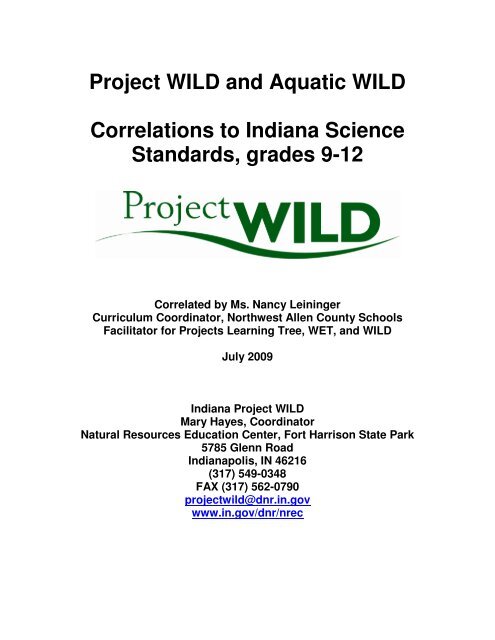
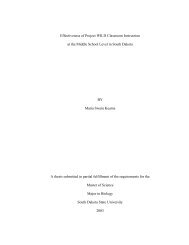
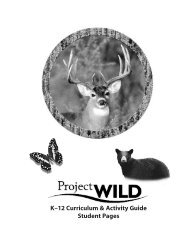
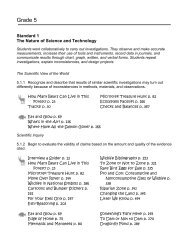
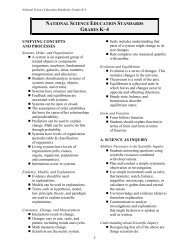
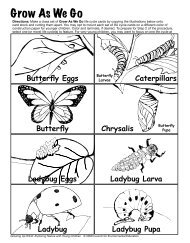
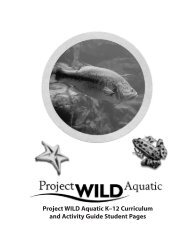
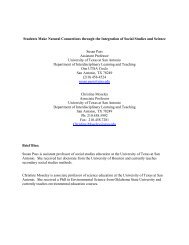
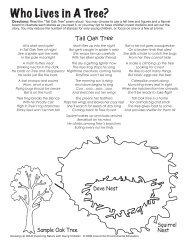
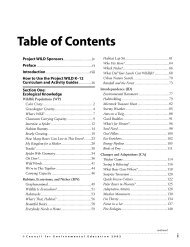
![Conceptual Framework [PDF] - Project Wild](https://img.yumpu.com/34019659/1/190x247/conceptual-framework-pdf-project-wild.jpg?quality=85)
